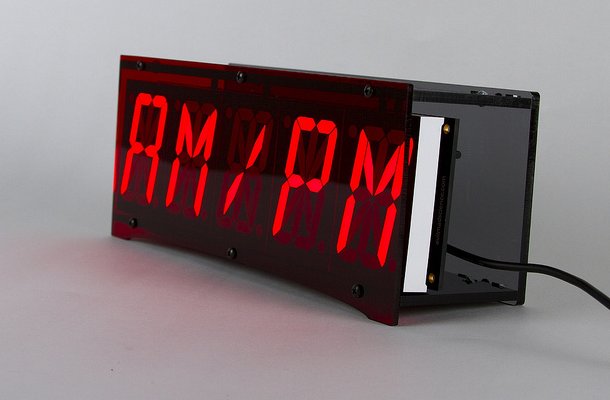**People have been “keeping” time for just about five or six thousand years. They have been systematically measuring time by the hour for just about two centuries. All this amounts to less than 1% of human history.
**

Photo credit: Oskay
Before the modern era, there was no obvious reason to doubt the utility of the sun’s rough position in the sky for knowing the ’time’ of day. And yet here we all are, minding the clock in the interest of “saving time.” How did it get to be this way? And what does it have to do with a.m. and p.m.? Let’s learn the basics and the backstory.
Morning, Noon and Night
Today’s 12-hour clock divides the day into two equal halves—ante meridiem and post meridiem. Then those halves are divided into twelve pieces, or “hours,” each.
What does AM and PM stand for? AM—also spelled “am” or “a.m."—is the abbreviation for ante meridiem, a Latin phrase meaning “before noon.” PM—also spelled “pm” or “p.m."—is the abbreviation for post meridiem, which simply means “after noon.” Noon, of course, refers to the middle of the day.
AM and PM are associated with 12-hour timekeeping, as opposed to the international 24-hour clock. The 12-hour system grew up mainly in Northern Europe, and spread globally from there via the British Empire. Meanwhile, the 24-hour system prevailed almost everywhere else and eventually became the global time-telling standard, leaving the AM/PM convention to a handful of countries that were already used to it, like the UK and U.S.
A Stitch in Time Saves Twelve
AM describes the first 12 hours in the day, occurring from midnight to high noon, while PM describes the last 12 hours, from high noon to midnight. This bisecting convention pivots the day around the number twelve. Its early adopters thought the 12-hour system rendered a cleaner and more economical clock face: instead of marking all 24 hours, it would display half as many, and the hands could simply spin around the circle twice in a day instead of once.
Moreover, on a 12-hour clock, the number 12 doesn’t really 12. It actually functions as zero. We use 12 instead because the concept of “zero”—a non-numerical value—had not yet been invented when ancient sundialers first segmented the day on either side of the highest sun.
A Good Time Was Had By All
Can you imagine having to convert to entirely different time measurement systems whenever you traveled from one town to another? The patchwork of practices preceding the modern era meant that one town might start the day at sunset, while its neighbor began at midnight, and the hinterlands at noontime. For millenia, everyone had simply developed what worked for their group.
This kind of local variation really didn’t matter back on the farm, when work was in sync with natural cycles—but things were changing. Merchants were none too pleased with the complex conversion tables needed to conduct interregional business. AM and PM terminology were introduced in the 16th and 17th centuries, respectively, as part of a wider movement to establish a blueprint for time that everyone could agree on.
Time is Money: Golden Age of Timekeeping
The terms AM and PM appeared first in Northern Europe, at the beginning of what would become a full-fledged industrial revolution. Farmers, long tuned to the natural timekeeping of the sun, abandoned their fields to find work in urban areas.
These men and women left their rural scheduling traditions behind them to become wage laborers in the city—a quickened world of structured work shifts and time cards that needed to be punched.
For the first time in history, personal timekeeping was becoming a necessity for ordinary working people. Suddenly there was a compelling reason to know, not only whether it was the morning or afternoon, but which fraction of the morning or afternoon it was. After all, employers reasoned, workers could hardly rely on the slow-but-steady motion of the sun and moon to show up to shifts on time. We have, in a sense, been “on the clock” ever since.
The transformation would not be complete, however, until the ‘golden age of the wristwatch’—the 20th century. It would be the most time-regimented centenary humanity had yet seen. Today, we hardly question the ubiquitous watches, clocks and schedules that govern all our lives, but this temporal system was an historical novelty not so long ago.
Bonus Facts To Arouse Your Curiosity###
Since Time ImmemorialThe division of the day into more precise time units was not a new concept when the terms AM and PM were introduced. Ancient Egypt had a very successful timekeeping system, and so did the Mesopotamians in the Fertile Crescent.
All in Good Time
The Egyptians developed sundials for measuring the daytime and water clocks for tracking the night. Although these first efforts were imperfect, they formed the basis for the 12-hour scheme on which AM and PM are based.
How Many Hours is Twelve Hours?
The Romans, like the Greeks, Jews and other ancient civilizations, defined the day as twelve hours year-round and regardless of location. This meant the “12-hour” day varied seasonally and geographically between 9 and 15 modern hours per diem. An hour was simply thought of as 1/12th of the stretch from sunrise to sunset.
Meridiem or Meridian?
Meridiem—as in ante meridiem—is not the same word as “meridian.” The two words are spelled the same because they’re both based on the Latin word for the middle of the day—meridies. Placed in front of a preposition such as ante or post, meridies must be spelled as meridium, per Roman grammar.
Prime Time
A “meridian” is an imaginary line drawn in the sky at high noon which divides the AM from the PM sky. Isn’t that the same thing as the middle of the day? Yes, essentially. However, “meridian” usually refers to the lines of longitude on which Time Zones are based—most notably the Prime Meridian in Greenwich, England.